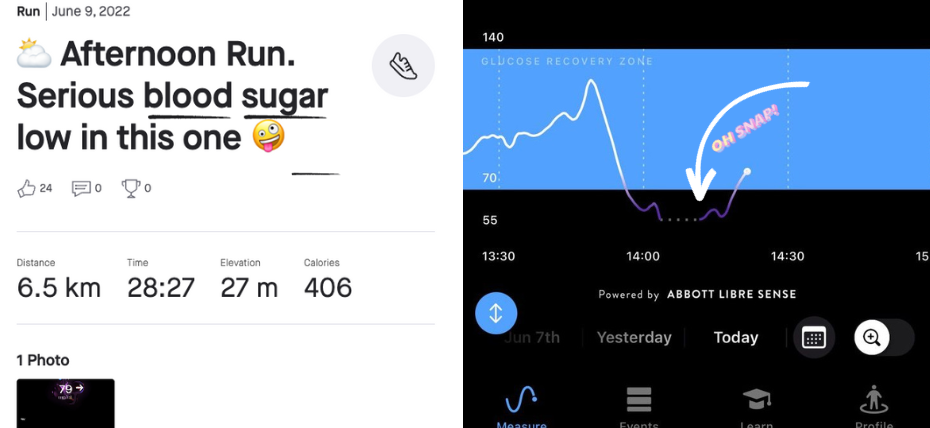We know that carbohydrates are the main source of fuel used during endurance exercise.
But, to put yourself in a position to perform at your best on race day, you also need to consider how to optimise your carb intake before exercise.
First up, you’ll want to start by carb-loading in the 2-3 days before race day to help fill your muscle glycogen stores. Your final pre-event meal on the day is then your second line of defence. This meal replenishes liver glycogen, as it’s typically depleted overnight.
If you’ve checked off those two boxes, you’re likely in a solid place. But could you be in a better place? That brings us to the start line and the 10-15 minutes before you start doing your thing…
How to pre-fuel
68% of the athletes whose race nutrition strategies we dissected in the 392 Case Studies on our site at the time of writing took a final pre-race gel or chew in the last 30 minutes or so before their event.
Eating immediately before exercise is referred to as your “pre-fuel strategy”, but it actually operates more like part of your in-race nutrition plan. Even easily digestible carbs have a lead time before they’re accessible for your body to use as energy.
This delay provides an opportunity to get ahead with your on-course nutrition, rather than trying to fuel a few minutes in when adrenaline is high and you’re breathing hard, or waiting until you’ve already burned a chunk of your energy stores.
Consider the following if you’re planning on taking a final hit of carb before exercise:
- Go with simple, quick digesting carbohydrates, in order to avoid disturbing the gastrointestinal system
- Aim to take ~30g of carbohydrate about 15 minutes before you start
- Avoid fibre, fat and protein - they have their benefits as part of your daily diet, but aren’t the best options so close to exercise
- Consider the format of carb. Since you’re not sprinting to the start line and breathing heavily, you might prefer a chew over a gel (and this may help delay flavour fatigue later in the event). On the other hand, if you’re someone who struggles with the mental aspect of eating right before a session, a gel would probably be easier to get down
- Our Fuel & Hydration Planner recommends taking a PF 30 Caffeine Gel as your pre-fueling option for the extra boost caffeine can give you. Whether you use caffeine or not will depend on how well you tolerate caffeine. Use this guide to work out whether caffeine is right for you
Wait, what about reactive hypoglycemia?
If you’ve had a bad experience with reactive (aka rebound) hypoglycemia, hesitation around eating food too close to exercise is justifiable.
Reactive hypoglycemia occurs when your blood sugar drops after eating. Symptoms can include feelings of dizziness, shakiness or light-headedness.
The problem occurs when insulin and exercise end up doing the same job at the same time, clearing out blood glucose too fast. (It’s a bit like sharing a post-run pizza with an equally ravenous training partner – the pizza gets eaten up way faster than when one person is eating alone!). When there’s sugar in your bloodstream, insulin’s job is to let the sugar move into your cells.
Exercise also stimulates the uptake of blood glucose and can help improve insulin sensitivity – making you more receptive to insulin’s work. There’s a reason exercise is often prescribed for those who demonstrate insulin resistance. When those two are on the same schedule, blood glucose can be wiped out too fast, causing the dreaded hypoglycemia dip.
Here’s what hypoglycemia can look like on a continuous glucose monitor - note the huge drop in Andy’s graph…

Eating an hour before exercise to give your food time to digest seems like common sense. However, Zignoli et al (2023) found that the majority of reactive hypoglycemia events (blood glucose concentrations of <70 mg/dL in the first half hour of exercise) occurred from meals eaten 30-90 minutes pre-exercise. The peak was in fact at about the 60-minute mark.
The kicker for reactive hypoglycemia is that you may or may not be affected at all. Some athletes are more at risk than others.
As a dietitian, I worked with an athlete who typically trained after an early dinner. She rightfully thought since she’d had a full day of eating under her belt, she was fueled. But reactive hypoglycemia had other plans. Adding a quick carb intake during her warm-up (fruit snacks in this case) made a noticeable difference.
Personally, I’ve even found eating my pre-workout snack before I drive to the gym is less favourable than saving it for when I get there. On the flip side, I’ve had plenty of other athletes who go into training sessions two hours after their last meal and feel better than ever. The key is knowing how your body reacts.
Should I only pre-fuel before races?
As with so much of sports science, the simple answer is ‘it depends’. (Don’t you love that answer?!)
If you struggle with reactive hypoglycemia, you’re more likely to benefit from an extra top off regardless of if it’s before a race or an ‘average training day’. If you tend to feel fine, then maybe save it for your most gruelling sessions.
In a similar vein, you’ll benefit from pre-fueling if you’re operating from an energy deficit. Perhaps you forgot to pack lunch, have had a string of sleepless nights or are trying to cut weight. A drop in the bucket makes a bigger splash when the bucket’s pretty empty.
As with all aspects of your fueling strategy, you should certainly try pre-fueling out in training before race day. As the old adage goes, ‘nothing new on race day!’.
But I get really nervous pre-race...
I know some athletes struggle to stomach anything before races because of nerves.
Ultimately, your priorities should still be carb loading (to top off your muscle glycogen) and a morning meal of (to stock up your liver glycogen, which can deplete overnight whilst you sleep), as well as nailing your race nutrition strategy during the event.
The final carb top off ~15 minutes before is a bonus point that would contribute to your fueling and help you get that little bit extra out of your performance.
Try it during training, see how you feel, observe your stomach and blood sugar reaction. But, if it’s stressful to incorporate pre-fueling into your routine, you’re not necessarily leaving PRs on the table just because you passed up a pre-race gel or chew.
If you suffer with a nervous stomach and struggle to get solid calories in before races, an alternative to gels and chews would be to use the PF Carb Only Drink Mix. One option would be to add two scoops to a 500ml (16oz) bottle and sip to thirst during the build-up to your race. If you don’t want to drink that much, consider adding two scoops to 250ml (16oz) to deliver 30g of carb.
As with all aspects of your race nutrition strategy, pre-fueling is a tactic that you should test out and refine in training so that you can be confident that it’s right for you on race day.
